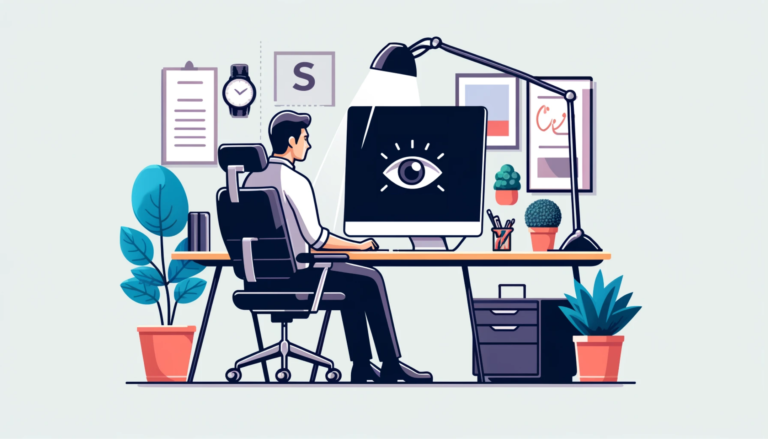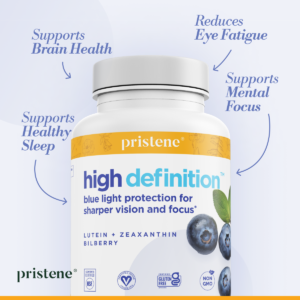Eye strain, or its medical term, asthenopia, describes a group of symptoms that often occur when using your eyes for a long period of time or for visually intense tasks. When eye strain is caused by use of digital screens or devices it’s known as Computer Vision Syndrome or Digital Eye Strain. Performing tasks that require increased cognitive demand (more intense concentration or reading challenging material has been shown to exaggerate the effect of visual stressors and intensify symptoms. [5]
Although a majority of people experience eye strain at some time or another, there are no medical treatments for it, and it usually resolves once your eyes have a chance to rest.
Although a majority of people experience eye strain at some point, there are no medical treatments for it.
Minimize Conditions, Your Environment and Behavior that Aggravates Digital Eye Strain
Here are tips and recommendations for how to minimize the conditions, your environment or behavior leading to eye strain symptoms. If steps are not taken to address the cause of the eye strain, it’s expected that symptoms will recur or possibly intensify. Causes contributing to symptoms of eye strain include:
- Dim or poor lighting
- Glare from digital screens
- Improper viewing distance
- Poor work-space ergonomics (monitor too high or seat too low)
- Improperly corrected or uncorrected refractive error (myopia [nearsightedness], hyperopia [farsightedness], astigmatism, presbyopia) – need for corrective lenses, glasses or contact lenses.
- Age related accommodative capacity (ability for eyes to work together)
- Binocular Problems (ability for eyes to work together)
- Some medications
- Bright or high glare outdoor environments
20/20/20 Method – An Essential Break For Eye Strain
Take a break and practice the 20/20/20 method – For every 20 minutes using a computer or intensely focusing on a screen, it’s recommended to shift your focus to a far distance (at least 20 feet away) to close for 20 seconds.
Don’t worry that taking short breaks may reduce productivity. A study of data entry workers found frequent, short breaks can relax the eye muscles used to focus on close work, providing some relief from eye strain symptoms, without loss of productivity. [4, 2]
Glasses and Contact Lenses Impact on Eye Strain
Check your glasses or contact lenses – Old glasses or requiring an updated prescription can lead to eye strain. Even minor vision problems can negatively impact eye comfort and performance. Uncorrected vision problems like nearsightedness (myopia), farsightedness (hyperopia) and astigmatism, or changes related to age (presbyopia) or the inability for eyes to work together to focus (accommodation capacity) can all contribute to the development of eye strain.
Needing glasses or an updated prescription can lead to eye strain, even very minor vision problems can negatively impact eye comfort and performance.
Make Sure to Get Regular Eye Exams
Regular eye exams are recommended to check your corrective lenses prescription or perhaps need to prescribe longer work distance “computer glasses”. Wearing glasses with an incorrect prescription typically intensifies symptoms. It is also important to communicate with your eye care professional if you are experiencing eye strain because they may recommend lens options to reduce glare. Additionally, some people who do not wear glasses on a regular basis can benefit from specifically prescribed glasses for computer use, as mentioned.
Adjust Digital Device Settings
Adjusting the settings on your digital devices – Viewing a digital screen or computer screen is quite different than reading a printed page. The letters on a screen display with less contrast between the background and the letters themselves, and reflections and screen glare all contribute to viewing difficulties and visual discomfort.
- Increasing the font size – adjust your computer settings to increase the size of the display font. The type of font you use can also make a difference. Sans-serif fonts (like Arial) are more eye-friendly.
- Font and display contrast – a simple black text on a white background or similar dark/light combinations are best for eye comfort.
- Reduce glare – adjust your digital screen settings to reduce the brightness and glare or request that special anti-reflective coatings be added to the lenses of your glasses. Some people find that if they adjust the brightness of their screen to more closely align with the natural light in the workspace, it can reduce eye strain symptoms. Adjusting this setting may take trial and error to find what works best for eye comfort.
- Check your screen’s color temperature – Blue light emitted from a computer screen has been shown to increase eye strain symptoms, and if used later in the day, disrupt circadian rhythm and sleep. Some computers allow for a more yellow color temperature adjustment within the operating system settings menu, while some monitors have this adjustment available directly on the physical monitor exterior.
Are You Blinking Enough? Dry Eyes Can Make Eye Strain Worse
Blink more frequently and completely – Studies have shown that during intense concentration and computer or smartphone use, people tend to blink less frequently or do not blink at all. This situation does not provide the eye with adequate moisture and lubrication.
Research has shown that people blink 17 times per minute during conversation, which is significantly reduced to only six times per minute while reading. [6] Studies have also reported the use of digital devices increases the rate of incomplete blinks (not completely closing and opening eyes) to 15%. [1] Blinking provides the eye with a natural refresh. Some people find that the use of artificial tears is helpful.
Check Computer Angle and Distance To Help Eye Strain
Check your angle and distance – The distance and angles of digital screens may contribute to eye strain, reducing the quality and frequency of blinking, altering eye muscles movement, and overall putting added demand on eyes.
Sometimes corrective lenses are not prescribed for optimal use for computer screens. Teleworkers can find themselves needing to tilt their head at uncomfortable angles in order to see clearly. Awkward angles and head and body positioning can lead to muscle pain in your neck, back and shoulders. Each person will have a preference as to where their screen set up is most comfortable for them. Some guidelines are below.
The distance and angles of digital screens can put added demand on the eyes, contributing to eye strain. Try to achieve a 30-degree declination by combining a 15-degree forward head tilt down with a 15-degree eye gaze down.
Computer screens located within the range of 15 to 27 inches away from eyes have been shown to provide less eye strain for the majority of computer users.
At rest, eyes naturally tend to look straight ahead and slightly downward. It is recommended then that for comfortable positioning of a computer screen, it should be approximately 15 degrees below horizontal. Studies have shown that people who are required to look upward toward a screen tend to tire more quickly as compared to those allowed to look slightly downward. For people that wear corrective lenses for close work, such as bifocals or reading glasses, they may prefer to have the top of the monitor located slightly below eye level.
Positioning a computer screen to reduce glare from window reflections and overhead lights is beneficial in reducing eye strain. Reflection can be reduced by using lower wattage lights overhead or adding window blinds. In some environments it is not possible to modify factors contributing to reflection or glare, so an anti-glare screen filter should be considered.
Good Light Helps Protect From Digital Eye Strain
Good light sources – Trying to see something in dim light can cause eye strain. Ensure that older workers in particular have sufficient light to see properly.
Environment Impact on Digital Eye Strain
Check your environment – Some people find that increasing the humidity in their environment and limiting circulated air (fans or air conditioners in home, office, or vehicle) can lessen the intensity of eye strain symptoms. Unfortunately, many office environments have low humidity, ventilation fans, air conditioning, and airborne dust particles.
These are typically factors that cannot be controlled by the individual but nonetheless cause dry eyes and eye strain symptoms. [3] Studies have shown the use of lubricating drops or daily dietary supplementation containing omega fatty acids can reduce symptoms such as tiredness, dryness and difficulty focusing during sustained computer use.
Diet, Supplements, and Exercise for Eye Strain
Daily dietary eye supplementation containing omega fatty acids can reduce symptoms such as tiredness, dryness and difficulty focusing during sustained computer use.
Exercise – For some people, poor accommodative capacity of their eye muscles are an issue. That is the two eyes do not work well or cooperatively together. eye exercises, called “pencil push-ups” may be recommended. While wearing your glasses or contact lenses, hold a pencil upright about 12 inches in front of your nose.
If you are able to clearly see the tip of the pencil, then slowly bring it closer to your nose. As you bring it nearer, the tips of the pencil may become blurry or appear to split into two (double vision). The objective of the exercise is to try to hold clear focus on the pencil tip as it gets closer to your nose. Hold the focus for three seconds, then move the pencil back and let your eyes relax.
It is recommended to repeat this exercise ten times. Performing this exercise will likely cause your eye muscles to feel strained, much like exercising your other muscles. It is thought that consistently performing this exercise and increasing your ability to focus on the pencil tip closer and closer to your nose will improve your ability to accommodate, and keep focus on modern display screens.
References:
[1] Argilés M, Cardona G, Pérez-Cabré E, Rodríguez M. Blink Rate and Incomplete Blinks in Six Different Controlled Hard-Copy and Electronic Reading Conditions. Invest Ophthalmol Vis Sci. 2015 Oct;56(11):6679-85. https://www.ncbi.nlm.nih.gov/pubmed/26517404
[2] Balci R, Aghazadeh F. The effect of work-rest schedules and type of task on the discomfort and performance of VDT users. Ergonomics 2003;46:455–65. https://www.ncbi.nlm.nih.gov/pubmed/12745696
[3] Blehm C, Vishnu S, Khattak A, Mitra S, Yee RW. Computer vision syndrome: a review. Surv Ophthalmol. 2005 May-Jun; 50(3):253-62. https://www.ncbi.nlm.nih.gov/pubmed/15850814
[4] Galinsky T, Swanson N, Sauter S, et al. Supplementary breaks and stretching exercises for data entry operators: a follow-up field study. Am J Ind Med 2007;50:519–27. https://www.ncbi.nlm.nih.gov/pubmed/17514726
[5] Gowrisankaran S, Nahar NK, Hayes JR, Sheedy JE. Asthenopia and blink rate under visual and cognitive loads. Optom Vis Sci. 2012 Jan; 89(1):97-104. https://www.ncbi.nlm.nih.gov/pubmed/22051780
[6] Schlote T, Kadner G, Freudenthaler N. Marked reduction and distinct patterns of eye blinking in patients with moderately dry eyes during video display terminal use. Graefes Arch Clin Exp Ophthalmol. 2004 Apr; 242(4):306-12. https://www.ncbi.nlm.nih.gov/pubmed/14747951








